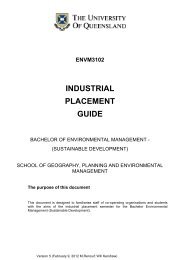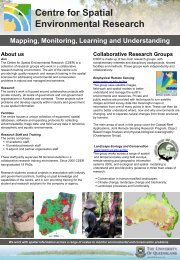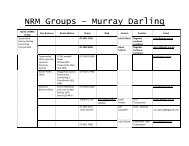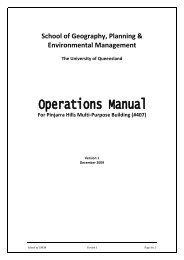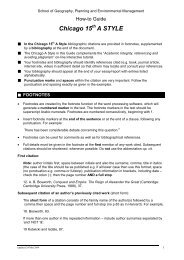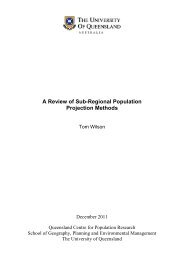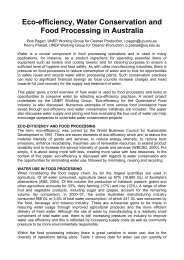Conserving Biodiversity in Brigalow Regrowth - School of ...
Conserving Biodiversity in Brigalow Regrowth - School of ...
Conserving Biodiversity in Brigalow Regrowth - School of ...
You also want an ePaper? Increase the reach of your titles
YUMPU automatically turns print PDFs into web optimized ePapers that Google loves.
CONSERVING BIODIVERSITY IN BRIGALOW LANDSCAPES<br />
<strong>Regrowth</strong> is important<br />
<strong>Regrowth</strong> represents a conservation barga<strong>in</strong> because regrowth can grow <strong>in</strong>to mature woodlands without the large<br />
<strong>in</strong>vestment <strong>of</strong> time and resources associated with tree plant<strong>in</strong>g schemes. <strong>Brigalow</strong> has a remarkable capacity to<br />
regrow from root stock <strong>in</strong> the soil, sometimes even after a decade <strong>of</strong> cultivation.<br />
Long regarded as a nuisance by<br />
landholders, brigalow regrowth<br />
currently occupies large areas <strong>in</strong><br />
the <strong>Brigalow</strong> Belt. In comparison<br />
to tree plant<strong>in</strong>g, brigalow regrowth<br />
<strong>of</strong>fers a cost-effective and less<br />
labour-<strong>in</strong>tensive means for<br />
conduct<strong>in</strong>g broad-scale habitat<br />
restoration. This does not mean<br />
that restoration <strong>of</strong> habitat is without<br />
costs for the landholder – the<br />
choice to allow brigalow regrowth<br />
to regenerate could result <strong>in</strong> lost<br />
production. An <strong>in</strong>creas<strong>in</strong>g number<br />
<strong>of</strong> government-funded schemes<br />
provide compensation funds to<br />
landholders who restore former<br />
production lands.<br />
The structure and floristic<br />
composition <strong>of</strong> brigalow regrowth<br />
vegetation is <strong>of</strong>ten very different<br />
from the orig<strong>in</strong>al remnant<br />
woodlands.<br />
Above: The number <strong>of</strong> woodland dependent bird species occupy<strong>in</strong>g regrowth stands<br />
<strong>in</strong>creases with woodland age. After 30 years, regrowth can support as many bird<br />
species as remnant woodlands.<br />
After clear<strong>in</strong>g, young brigalow<br />
regrowth (≤15 years) is low,<br />
with no trees and few shrubs (apart from the brigalow<br />
itself). Intermediate age regrowth (16 – 30 years) exhibits<br />
characteristics overlapp<strong>in</strong>g both young and old regrowth,<br />
but is <strong>of</strong>ten more similar to old regrowth. Old regrowth (><br />
30 years) is taller, has fewer stems and a more ‘tree-like’<br />
shape than the younger shrubby regrowth. Fallen timber,<br />
hollows and a complex ground and shrub layer are still<br />
miss<strong>in</strong>g from old regrowth and may take more than 100<br />
years to develop. These differences <strong>in</strong> the characteristics <strong>of</strong><br />
regrowth woodland compared with remnant brigalow mean<br />
that regrowth does not provide identical habitat as the<br />
orig<strong>in</strong>al woodland.<br />
Over time, brigalow regrowth can develop <strong>in</strong>to important<br />
habitat. Few woodland birds are able to use brigalow<br />
regrowth <strong>in</strong> the first couple <strong>of</strong> decades <strong>of</strong> growth, but after<br />
30 years the regrowth can support the same number <strong>of</strong><br />
species that are found <strong>in</strong> mature woodlands.<br />
This does not mean that only old regrowth is valuable for<br />
fauna. Long before it can provide habitat for a diverse<br />
range <strong>of</strong> species, it can provide other benefits such as<br />
provid<strong>in</strong>g movement pathways for species that cannot<br />
cross paddocks and crops. The dense shrubby structure <strong>of</strong><br />
young regrowth is important breed<strong>in</strong>g habitat and shelter<br />
for animals hid<strong>in</strong>g from <strong>in</strong>troduced predators like cats and<br />
foxes. T<strong>in</strong>y birds like the superb and variegated fairy-wrens<br />
love to hide their nests <strong>in</strong> the young brigalow shrubs.<br />
Remnant<br />
CleareD<br />
Young regrowth<br />
(< 15 yrs)<br />
<strong>in</strong>termediate<br />
regrowth (15- 30 yrs)<br />
OLD regrowth<br />
(> 30 yrs)<br />
15




